41 Service Battalion
| 41 Service Battalion | |
|---|---|
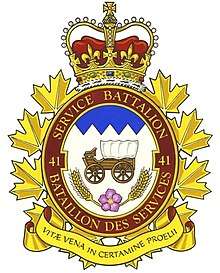 41 Service Battalion Badge | |
| Active | 1910-Present |
| Country |
|
| Branch |
|
| Type | Combat Service Support |
| Part of | 41 Canadian Brigade Group, 3rd Canadian Division |
| Garrison/HQ | Calgary, Alberta, Edmonton, Alberta |
| Motto(s) | Vitae Vena In Certamine Proelii (The Lifeblood in Battle)[1] |
| Commanders | |
| Commanding Officer | Lieutenant-Colonel Peter J. Boyle[1] |
| Regimental Sergeant Major | Chief Warrant Officer Mark Noble[1] |
| Abbreviation | 41 Svc Bn |
41 (Alberta) Service Battalion is a Canadian Army Primary Reserve Combat Service Support unit with three Companies located at Currie Armoury in Calgary and at Debney Armoury in Edmonton, Alberta, Canada. The Battalion is under the command of 41 Canadian Brigade Group, itself part of the 3rd Canadian Division, one of four region-based Canadian Army divisions. The Battalion is made up of Officers and Soldiers primarily from the Corps of Royal Canadian Electrical and Mechanical Engineers and the Logistics Branch and provides transport, maintenance, supply, food services and administrative support to 41 Canadian Brigade Group and other military elements in southern Alberta.
Sub-Units
14 Service Company - Calgary.
15 Service Company - Edmonton.
Mountain Operations
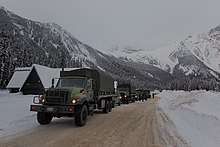
With its close proximity to the Rocky Mountains, 41 Service Battalion often trains in this environment to develop soldier skills for operating in the mountains. This includes driver training, winter warfare and winter survival. Mountain Operations includes many civilian skills such as avalanche awareness, wildlife awareness and basic mountaineering. As well, military specific skills are taught such as Mountain Operations, austere vehicles (Quads, Side-by-sides etc.) and aerial replenishment (Helicopters and UAVs).

History
The history of 41 Service Battalion begins with the formation of No. 14 Company, Canadian Army Service Corps (CASC) in Calgary on April 1, 1910. In Edmonton, No. 22 Company, Canadian Army Service Corps (CASC) was formed in 1922. The Battalions lineage is complicated by the move from a horse based military in 1910 to the modern automated force of today. This has caused the formation of new Corps such as the Royal Canadian Electrical Mechanical Engineers (RCEME) to maintain the complex equipment as well as it has seen the amalgamation of other Corps such as the Royal Canadian Army Service Corps and Royal Canadian Ordnance Corps under the combined Logistics title. Through these changes, the Battalion has served in communities across the Province in peacetime as well as in almost every conflict including the First World War, the Second World War, Peacekeeping and the conflict in Afghanistan. The largest change to the organization was the formation of the experimental Service Battalion concept in the mid-1960s which saw various Corps being brought together in one organization including the Royal Canadian Army Service Corps (RCASC), the Royal Canadian Ordnance Corps (RCOC), the Royal Canadian Pay Corps, the Royal Canadian Postal Corps and the Royal Canadian Electrical Mechanical Engineers (RCEME). Other Corps, including Military Police and Medical have been included for short periods of time. The unification of the Canadian Armed Forces brought greater change with the merging of the RCASC and RCOC under the Logistics Branch. No matter the construct of the Battalion, the goal has always been to provide Combat Service Support to the units that it is tasked with sustaining during war, peace and during domestic emergencies. The motto, "The Lifeblood in Battle", signifies the objective of the soldiers of the Battalion at all times.
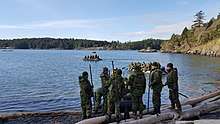
Antecedent Units
Royal Canadian Electrical Mechanical Engineers (RCEME)
1946-1950: No. 22 Armoured Workshop, RCEME;[2]
1950-1954: Recovery Troop, 39 Technical Squadron, RCEME;[3]
1954-1965: 31st Technical Squadron, 9th Technical Regiment, RCEME.[4]
- 31st Technical Squadron, RCEME had a band in 1961.
Royal Canadian Army Service Corps (RCASC)
1910-1922: No. 14 Company, 5th Mounted Brigade, CASC;[5]
1922-1926: Headquarters and No. 1 Company, 13th Divisional Train, CASC;[6]
1926-1931: Headquarters and No. 1 Company (Mechanical Transport), 13th Divisional Train, CASC;[7]
1931-1936: Headquarters, Supply, Baggage and Ammunition Companies (Maintenance Company in Edmonton).

1936-1942: 2nd (Reserve) Corps Troop Column, RCASC.[8]
Force Generated by 2nd (Reserve) Corps Troops during the Second World War:
- 1st Divisional Ammunition Company (Raised in 1939) under the command of Maj. R.V. Jones. It saw action in Italy, Holland and Germany under the following names:
- 1939-1942: 1st Divisional Ammunition Company, RCASC;
- 1942-1945: 1st Canadian Infantry Brigade Company, RCASC.
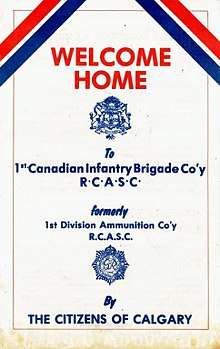
1942-1946: 4th (Reserve) Armoured Division, RCASC (This included: 4th (Res) Armd Div Sup Gp, 3rd (Res) Armd Brigade Coy, 4th (Res) Armd Brigade Coy, 4th (Res) Armd Brigade Sup Coy and 4th (Res) Div Troops Coy (Edmonton));[9]
1946-1947: Headquarters, RCASC, 2nd Corps Troops, RCASC (Mewata Armoury);[10]
1947-1954: Headquarters, 2nd Corps Troops Column, RCASC;[11]
1946-1947: No. 32 Corps Troops Composite Company, RCASC;[11]
1947-1948: No. 32 General Transport Company, 2nd Corps Troops, RCASC;[11]
1946-1947: No. 33 Corps Troops Composite Company, 2nd Corps Troops, RCASC (Hanger #6 Currie Barracks);[11]
1947-1954: No. 33 Supply Company, 2nd Corps Troops, RCASC (Hanger #6, Currie Barracks);[12]
1946-1947: No. 35 Corps Transport Company, 2nd Corps Troops, RCASC;[11]
1947-1948: No. 35 Corps Troops Transport Company (Heavy), 2nd Corps Troops, RCASC (Hanger #6, Currie Barracks);[11]
1947-1954: No. 35 General Transport Company (Heavy), 2nd Corps Troops, RCASC[13] (Hanger #6, Currie Barracks);[14][15]
1954-1965: Headquarters and 150 Company, 7 Column, RCASC.[16][17]
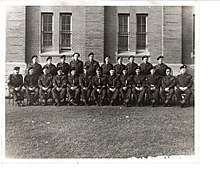
Royal Canadian Ordnance Corps (RCOC)
1909-????: Number 13 Detachment, COC;
1921-1936: 13 Detachment, RCOC;
1936-1941: No. 6 Army Field Workshop, RCOC;[18]
1936-1941: No. 13 District Stores Section, RCOC;[18]
1941-1944: No. 1 (Reserve) Army Ordnance Workshop, RCOC;[19]
1941-1944: No 1 (Reserve) Armoured Divisional Workshop, RCOC;[20]
1941-1944: No. 3 (Reserve) Divisional Ordnance Field Park, RCOC;[21]
__________________________________________________________
Overseas Units raised in Canada
1939-1940: 2nd Division, Mobile Bath Unit, RCOC;[22]
1940-1945: 2nd Division, Mobile Laundry and Bath Unit (MLBU), RCOC;
__________________________________________________________
1944-1946: 2 (Reserve) Infantry Divisional Sub Park, RCOC;
1946-1947: 13th Infantry Divisional Sub Park, RCOC;
1947-1954: 18th Infantry Brigade Ordnance Field Park;[23]
1947-1952: HQ, Royal Canadian Ordnance Corps, 5th Division, RCOC;
1952-1965: 6th Ordnance Company, RCOC.
Royal Canadian Electrical Mechanical Engineers (RCEME)
1944-1946: No. 1 (Reserve) Armoured Brigade Workshop, RCEME;[24]
1942-1946: No. 2 Group, No. 10 (Reserve) Divisional Ordnance Workshop. Comprising
41 (A), 42 (B), 43 (B) and 44 (B) Light Aid Detachments, RCEME;
1946-1950: No. 22, Armoured Brigade Workshop, RCEME;[25]
1946-1950: No. 62, 141, 157, 169 Light Aid Detachment (Type B), RCEME;[26]
1950-1954: 39 Technical Squadron, RCEME;[3]
1954-1965: A Squadron, 9th Technical Regiment, RCEME.[27]
Canadian Provost Corps (C Pro C)
1963-1965: 14 Company, C Pro C;[28]
1975-1977: 14 (Calgary) Military Police Platoon (Within 14 (Calgary) Service Battalion);[29]
- In 2002, 14 Military Police Platoon was allocated to 15 Military Police Company in Edmonton;
2018–Present: 14 Military Police Platoon was attached to 41 (Alberta) Service Battalion.
Royal Canadian Army Medical Corps (RCAMC)
1914: No. 17 Company, Field Ambulance is listed as being in Calgary
1915-1954: 8th Field Ambulance, RCAMC;
1936: No. 13, Field Hygiene Section is noted in GO 213.
1954-1965: 21 Medical Company, RCAMC.[30]
- Medical Services moved to the Calgary Service Battalion, however became a separate organization in 1975 under the Royal Canadian Medical Services.
In 1963. the Canadian Armed Forces began testing a new Combat Service Support concept known as a Service Battalion which grouped together support functions.
1965-1975: Calgary Service Battalion - Initially established with Battalion Headquarters, No.150 Coy (RCASC), 21 Medical Company (RCAMC), 6 Ordnance Company (RCOC) and 14 Provost Company (C Pro C).[31] A Squadron, 9th Technical Regiment (RCEME) also became part of the Calgary Service Battalion at a similar time.[32]
1975-2010: 14 (Calgary) Service Battalion;
2010–Present: Headquarters and 14 Service Company, 41 Service Battalion.
Other Support Organizations
1998-2010: Area Support Unit (ASU) Calgary
*Formed following the closure of CFB Calgary, ASU Calgary was created. It was amalgamated with 41 Service Battalion in 2010 and is part of Headquarters Company, 41 Service Battalion.
Royal Canadian Ordnance Corps (RCOC)
1909-????: "C" Squadron, No. 13 Detachment, RCOC;[33]
Royal Canadian Army Service Corps (RCASC)
1950-1954: 32 General Transport Company, 2 Corps Troops, RCASC;[34]
1954-1961: 152 Company, 7 Column, RCASC;[35]
On 24 September 1961, Company was re-designated as "D Company", The Calgary Highlanders.
Royal Canadian Ordnance Corps (RCOC)
1939: 6th Field Workshop, RCOC.[36]
1942-1944: No. 1 (Reserve) Armoured Divisional Ordnance Workshop;[37]
Overseas Units raised in Canada
1941: 203rd Infantry Ordnance Sub-Park, RCOC.[38]
Royal Canadian Electrical Mechanical Engineers (RCEME)
1944-1946: No 2 (Reserve) Tank Troops Workshop, RCEME;[39]
1946-1950: No. 18 Infantry Workshop, RCEME.[40]
- No. 18 Infantry Workshop had a band in 1949.
Royal Canadian Army Service Corps (RCASC)
1921-1922: No. 22 Company, CASC;[41]

1922-1926: No. 2 Company, 13th Divisional Train, CASC;[42]
1926-1931: No. 2 Company (Horse Transport) and Supply Details, 13th Divisional Train, CASC;[43]
1931-1936: No. 13 Maintenance Company, 13th Divisional Train, CASC;[44]
1936-1942: 1 Company, 2nd (Reserve) Corps Troop Column, RCASC;
1942-1946: 4th (Reserve) Divisional Troops Company, RCASC;[45]
1947-1948: No. 51 Transport Company;
1946-1947: 45 Medium Regiment Platoon, RCASC;[46]
1947-1954: 45 Artillery Platoon, RCASC[47] (Prince of Wales Armoury);
1954-1965: 154 Company, RCASC[35] (Prince of Wales Armoury).
Royal Canadian Ordnance Corps (RCOC)
1954-1958: 7th Ordnance Battalion, RCOC;[48]
1958-1965: One Company, 7th Ordnance Battalion, RCOC;[49]
1965: 16 Ordnance Company. Was part of Edmonton Service Battalion (See Below).
Royal Canadian Electrical Mechanical Engineers (RCEME)
1948-1950: 44th Heavy Anti-Aircraft Workshop;[50]
1948-1950: 91,156th Light Aid Detachment (LAD), RCEME;[50]
1950-1965: 38 Technical Squadron, RCEME.[51]
Canadian Provost Corps (C Pro C)
1954-1965: 15 Company, C Pro C.
- 15 Provost Company fought in Northwest Europe during the Second World War.
Royal Canadian Army Medical Corps (RCAMC)
TBC: 17th Field Ambulance, RCAMC;
1954-1965: 23 Medical Company, RCAMC.[52]
In 1963. the Canadian Armed Forces began testing a new Combat Service Support concept known as a Service Battalion which grouped together support functions.
1965-1975: Edmonton Service Battalion - Initially established with Battalion Headquarters, No.154 Company (RCASC), 23 Medical Company (RCAMC), One Company from No. 7 Ordnance Battalion (RCOC), No 15 Provost Company (C Pro C), and 38th Technical Squadron (RCEME);[31]
1975-2010: 15 (Edmonton) Service Battalion;
2010–Present: 15 Service Company, 41 Service Battalion.
Royal Canadian Ordnance Corps (RCOC)
1909-????: "B" Squadron, No. 13 Detachment, RCOC;[33]
Royal Canadian Army Service Corps (RCASC)
1947-1954: HQ and 2 Transport Platoons, 49th "Tipper" Company, RCASC;[53][54]
1954-1964: HQ and 2 Transport Platoons, 153 Company, 7 Column, RCASC.[53][55]
- 49 Coy and 153 Company had Platoons in Turner Valley and Nanton (See Below);[56]
- 153 Company had Platoons in Medicine Hat (See Below).
- 153 Company had a Band which won the Colonel Jennings marching band trophy in 1959.
- On disbandment in 1964, the Company was re-designated as a Company of The Calgary Highlanders for a brief period.
Royal Canadian Electrical Mechanical Engineers (RCEME)
194?-1946: 42nd (Reserve) Light Aid Detachment (Type B), RCEME;
1946-1947: 140th Light Aid Detachment (Type B), RCEME;
1947-1950: No. 140 Light Aid Detachment (Type C) and No 142 Light Aid Detachment (Type B), RCEME;[57]
1950-1954: 1 Troop (Wheeled), 39 Technical Squadron, RCEME;[3]
1954-1958: 9 Technical Regiment HQ, RCEME (RCEME Armoury at Kenyon Airfield);[58]
1950-1965: 32nd Technical Squadron, 9th Technical Regiment, RCEME (RCEME Armoury at Kenyon Airfield);[59]
1964-1968: 142 Light Aid Detachment (LAD) and 43 Electrical Mechanical Platoon as part of 6th Field Park, Royal Canadian Engineers.[60]
Royal Canadian Army Service Corps (RCASC)
????-1965: Clerical Platoon (CWAC) and Transport Platoon (CWAC), 153 Company, RCASC.[61]
Royal Canadian Electrical Mechanical Engineers (RCEME)
1950-????(Existed in the mid-1950s): 26 Technical Squadron, 9th Technical Regiment, RCEME.[62]
Royal Canadian Army Service Corps (RCASC)
1947-1954: 2 Transport Platoons and 2 Relief Driver Increments, 49th "Tipper" Company, RCASC;
1954-1965: 2 Transport Platoons and 2 Relief Driver Icrements, 153 Company, 7 Column, RCASC.[63]
Royal Canadian Army Medical Corps (RCAMC)
1908-193?: 17th Cavalry, Field Ambulance, CAMC;[64]
193?-1954: 17th Field Ambulance, RCAMC;
1954-1965: 22 Medical Company, RCAMC.[65]
Royal Canadian Army Service Corps (RCASC)
1948-1954: No. 51 General Transport Company, RCASC[66] (Garrison Garage, Red Deer);[67]
1954-1965: 151 Company, 7 Column, RCASC[68] (Garrison Garage, Red Deer).[69]
Royal Canadian Army Service Corps (RCASC)
1947-1954: 2 Transport Platoons and 2 Workshop Platoons, 49th "Tipper" Company, RCASC;
1954-1964: 2 Transport Platoons and 2 Workshop Platoons, 153 Company, 7 Column, RCASC.
Royal Canadian Electrical and Mechanical Engineers
1947-194?: 44 Light Aid Detachment, 2nd (Reserve) Armoured Division, RCEME.
Bands
31st Technical Squadron, RCEME had a band in 1961 under the direction of Lt. F. Beddington, Director of Music. In 1962, it was under the direction of WO2 F. Edl.[70]

The Calgary units of the Royal Canadian Army Service Corps (RCASC) formed a band in 1932. The first public performance was on Sunday, March 12, 1933 at the Strand theatre. The original band wore a khaki uniform, however LCol MacMillan arranged for a dress blue uniform. Many of the band members went overseas in 1940 and a new trumpet and drum band was formed at Sarcee Barracks to replace this band. The latter was dissolved at the end of the war and a new RCASC band was organized by George Bealing in 1948. The band officially disbanded in 1963, with most remaining members transferring to the KOCR band.[71]
No. 18 Infantry Workshop, RCEME had a band in 1949. It was noted of a strength of 15 soldiers.
152 Company, 7 Column, RCASC had a band in 1954.
In 2017, 41 Service Battalion became associated the Clan McNaughton Pipes and Drums after many years of parading together at events in Edmonton.
No. 49 "Tipper" Company had an RCASC Band in 1953.
153 Company, 7 Column, RCASC had a band in 1954.
______________________________________________________
In 1954, it was noted that the Band-Master was WO1 I.J. Pickersgill.
*In 1957, the following bands were authorized. RCASC: 7 Column, 152 Coy and 153 Coy. RCEME: 31 Tech Sqn.[72]
Memorials
The Calgary Soldiers' Memorial lists the war dead of 41 Service Battalion from the Calgary-based antecedent units for the First World War and the Second World War.
A Memorial exists at The Military Museums for Royal Canadian Army Service Corps members.
Red Deer - A20 Advanced Training Centre Memorial. From 1941 to 1945, the A-20 Camp Site was home to thousands of Trainees. It was one of two advanced Training Centres in Canada for Service Corps. After receiving basic training at other centres around the Country, young Servicemen would come to Red Deer to learn skills related to supply and transport, such as driving and repairing army vehicles, reading maps, defending against gas attacks and even using guns. The Cairn is a result of efforts by retired Captain Alex Campbell of Toronto.[73]

Freedom of the City
- Calgary: 1982 (Granted to 14 (Calgary) Service Battalion);
- Edmonton: 1994 (Granted to 15 (Edmonton) Service Battalion).
Commanding Officers
- 2010-2011: LCol G. Haight, CD;
- 2011-2013: LCol D. Beauchamp, CD
- 2013-2017: LCol D.M. Sweeney, CD
- 2017–Present: LCol P.J. Boyle, CD
Regimental Sergeants Major
- 2010-2013: CWO M. Dijiker, CD;
- 2013-2016: CWO R. Pettit, CD
- 2016–Present: CWO M. Noble, KStJ, CD
Cadet Corps
Active
- 1955 Royal Canadian Army Cadet Corps - Calgary;
- 2467 Royal Canadian Army Cadet Corps - Westlock;
- 2733 Royal Canadian Army Cadet Corps - Edmonton;
- 3025 Royal Canadian Army Cadet Corps - Didsbury.
Disbanded
- 535 Royal Canadian Army Cadet Corps - Blairmore.
Re-badged
- 2383 Royal Canadian Army Cadet Corps (Now affiliated with The Calgary Highlanders) - Turner Valley.
Battalion Crest
The white peaks refer to the Rocky Mountains of Alberta, the province in which the unit is located. The wild rose is the provincial flower. The ears of wheat represent the prairie region of the province. The wagon was a vehicle used for combat service support during the early history of the Royal Canadian Army Service Corps.

Camp Flag
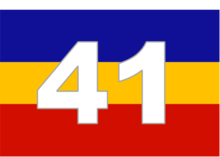
Notable Personalities
Lougheed, Clarence Hardisty: Son of James Alexander Lougheed, Edgar served with No. 14 Company and went overseas during the First World War as part of the Canadian Army Service Corps.
Lougheed, Edgar Donald: Son of James Alexander Lougheed and Father to Peter Lougheed, Edgar served with No. 14 Company and went overseas during the First World War as part of the Canadian Army Service Corps.
References
- 1 2 3 "41 Service Battalion". Canadian Army official website. Retrieved 18 October 2016.
- ↑ 22nd Armd Bde Workshop was authorized on 1 Apr 1946 under GO116. It was disbanded on 7 Jun 1950 under Canadian Army Order 78-3, Issue No. 184. Disbanded effective 7 Jun 1950 with the formation of 38 and 39 Tech Regt as per SD-1 (4008).
- 1 2 3 Formed effective 7 June 1950 under SD1-4008 dated 9 Jun 1950. Effective 7 June 1950. Based on 1951 Historical Report, this unit had an HQ Troop, 2 Recovery Troops and a Tank Troop in Calgary. A wheeled Troop in Lethbridge. A recovery troop in Blairmore. Strength at that time was Calgary detachment - 42 other ranks, Lethbridge detachment - 50 other ranks, Blairmore - 16 other ranks.
- ↑ 31 Tech Sqn was moved to the Supplemental Order of Battle effective 31 March 1965. A per Canadian Forces Headquarters SD 1 Letter No 64/58 - Dated 10 Dec 1964.
- ↑ Authorized 1 April 1910 - The Quarterly Militia List of the Dominion of Canada
- ↑ GO31 (15 Feb 1922). Reorganization of CASC to align numbers with Militia Districts (MD).
- ↑ GO30 (1 May 1926).
- ↑ Authorized 15 December 1936 as part of RCASC Reorganization.
- ↑ The reorganization of the reserve units of the RCASC effective 24 March 1942.
- ↑ Post WW2, the 4th Armoured Division designation was returned to 2nd Corps Troops. Effective 1 April 1946. Corps Troops had 4 Coys - 32 and 33 Composite Companies, 35 Transport and 45 Medium Regiment. See other locations for the distribution of these Coys. Re-designation occurred on 24 May 1946.
- 1 2 3 4 5 6 As per SD-1 3522 dated 26 Aug 1947 with effect 29 Jun 1947.
- ↑ Amalgamated with No. 35 Company to form 150 Company as per SD-1 54/109 (Dated 26 Oct 54), effective 19 Oct 54.
- ↑ CAO 412, 17 October 1954
- ↑ Effective 1 April 1946.
- ↑ Amalgamated with No. 33 Company to form 150 Company as per SD-1 54/109 (Dated 26 Oct 54), effective 19 Oct 54.
- ↑ Authorized 01 October 1954 Canadian Army Order 411 7 Column HQ was moved to the Supplemental Order of Battle effective 31 March 1965. A per Canadian Forces Headquarters SD 1 Letter No 64/58 - Dated 10 Dec 1964.
- ↑ 2nd Corps Troops HQ was re designated 7 Column.
- 1 2 13 Detachment, RCOC was divided into No. 6 Army Field Workshop and No. 13 District Stores Section on 15 Dec 1936. General Order 181/1936.
- ↑ No. 6 Army Field Worshop was re-designated as No. 1 (Reserve) Army Ordnance Workshop and No. 1 (Reserve) Armoured Divisional Workshop on 1 September 1941. General Order 290/1941.
- ↑ No. 6 Army Field Worshop was re-designated as No. 1 (Reserve) Army Ordnance Workshop and No. 1 (Reserve) Armoured Divisional Workshop on 1 September 1941. General Order 290/1941. This unit was re-designated as No. 1 (RCEME) Armoured Brigade Workshop, RCEME on 15 July 1944. General Order 431/1944.
- ↑ No. 13 District Stores Section was changed to No. 3 (Reserve) Divisional Ordnance Field Park. on 1 September 1941. General Order 290/1941.
- ↑ 2nd Div Mobile Bath Unit was mobilized in Calgary in December of 1939. Its exact relationship to the Militia RCOC of Calgary is unclear. It was merged with 2 Mobile Laundry and Bath Unit in August of 1940.
- ↑ Disbandment occurred 15 Dec 1954 as per SD1 54/131
- ↑ No. 1 (Reserve) Armoured Divisional Workshop, RCOC was re-designated as No. 1 (RCEME) Armoured Brigade Workshop, RCEME on 15 July 1944. General Order 431/1944.
- ↑ 22nd Armd Bde Workshop was authorized on 1 Apr 1946 under GO 116. It was disbanded on 7 Jun 1950 under Canadian Army Order 78-3, Issue No. 184. HQ was in Blairmore, however it is believed that there was a Det in Calgary (Likely a LAD).
- ↑ Authorized 1 April 1946. Disbanded effective 7 June 1950. Disbanded effective 7 Jun 1950 with the formation of 38 and 39 Tech Regt as per SD-1 (4008).
- ↑ Struck from Order of Battle 31 Mar 1965. Unclear how exactly it became the Maint Coy to Calgary Service Battalion.
- ↑ Authorized 1 Feb 1963.
- ↑ Authorized 11 Jul 1975. Amalgamated with 14 (Calgary) Service Battalion on 1 Aug 1977.
- ↑ From 1955 onward, 150 Coy provided transport. As per SD-1 (55/96).
- 1 2 Effective 1 January 1965.
- ↑ Have not been able to find a reference to this, however the Maintenance Company of the Battalion existed and must have been drawn from this unit.
- 1 2 Henderson's Directory 1911.
- ↑ An order dated 3 Nov 1950 asked for a Platoon of 32 Coy to be moved to Drumheller (From Calgary) following the disbandment of 18 Inf Bde Workshop and there being pers keen to be in the militia.
- 1 2 Authorized 01 October 1954 Canadian Army Order 411
- ↑ From military record of WO1 Bruce Johnson. 12 April 1939, he was sent to this unit. No other records for how long the unit was established.
- ↑ Converted to No 2 (Reserve) Tank Troops Workshop, RCEME on 15 July 1944.
- ↑ https://www.canadiansoldiers.com/organization/unitlistingbycorps/rcocorbat.htm It is unclear if this was a Militia Unit that was mobilized or if it was mobilized from scratch. Investigations continue.
- ↑ This unit was redesignated on 13 may 1946 to No. 18 infantry Brigade Workshop Uncertain when it was formed.
- ↑ It is unclear when this unit was formed. There was a re-designation that confirms that it was in Drumheller as of 19 Jun 1947 - CAO 76-3, Issue 63/47. Disbanded effective 7 Jun 1950 with the formation of 38 and 39 Tech Regt as per SD-1 (4008).
- ↑ Authorized 1 April 1921. As per 1925 Militia List.
- ↑ GO 31 (15 Feb 1922).
- ↑ GO30 (1 May 1926). Uncertain of "Supply Details".
- ↑ No. 13 Divisional Train had four Companies. Supply, Baggage and Ammunition (All based in Calgary) and Maintenance (Based in Edmonton) - Attached. Militia List of 1932.
- ↑ 4th (Reserve) Divisional Troops was formed in May 1942. HQ + 3 Coy in Calgary. 1 Coy in Edmonton.
- ↑ 1 April 1946.
- ↑ 45 Artillery Platoon, RCASC – Designated 154 Company by CAO 411, 01 October 1954
- ↑ Formed 21 Jul 1954 as per SD-1 54/88
- ↑ As per SD-1 58/46, Battalion was reduced to one company effective 31 Aug 1958.
- 1 2 Disbanded effective 7 Jun 1950 with the formation of 38 and 39 Tech Regt as per SD-1 (4008).
- ↑ Formed effective 7 June 1950 under SD-1 4008.
- ↑ From 1955 onward, 154 Coy provided transport. As per SD-1 (55/96).
- 1 2 Calgary, University of; Laval, Université. "Our Roots - Page view". Retrieved 2017-10-21.
- ↑ 49 Tipper Company, RCASC (Formed 05 June 1947) as per SD-1 3522 dated 26 Aug 1947 with effect 5 June 1947. – Designated 153 Company by CAO 411, 01 October 1954
- ↑ Moved to Supplemental Order of Battle - 6 Feb 1965. 153 Coy was moved to the Supplemental Order of Battle effective 31 March 1965. A per Canadian Forces Headquarters SD 1 Letter No 64/58 - Dated 10 Dec 1964.
- ↑ Calgary, University of; Laval, Université. "Our Roots - Page view". Retrieved 2017-10-21.
- ↑ No. 140 LAD - Organized 20 March 1942, GO 159/42; Redesignated 15 Jul 1944, GO 429/44; Redesignated 1 Apr 1946, GO 116/46; Converted and Redesignated 19 Jun 1947, CAO 76-3, Issue 43/47. Officer Commanding in the 1948 Militia List was Captain D.L. Hamilton. No. 142 LAD- Organized 20 March 1942, GO 159/42; Redesignated 15 Jul 1944, GO 429/44; Redesignated 1 Apr 1946, GO 116/46. Officer Commanding in the 1948 Militia List was Captain R.A. Reagh. Disbanded effective 7 Jun 1950 with the formation of 38 and 39 Tech Regt as per SD-1 (4008).
- ↑ With effect 31 Aug 1958, RHQ and HQ Sqn will be reduced to nil strength and classified as dormant "A" Sqn will continue to function on establishment. Letter from Army HQ - 19 Jun 1958.
- ↑ 32 Tech Sqn was moved to the Supplemental Order of Battle effective 31 March 1965. A per Canadian Forces Headquarters SD 1 Letter No 64/58 - Dated 10 Dec 1964.
- ↑ "BADGE - Results - Galt Museum". ginger.lethbridge.ca. Retrieved 2017-10-21.
- ↑ Unsure of when they were established. These two Platoons were moved to High River on order dated 10 Dec 1964 (To be effective 31 Mar 1965). The Platoons were moved "administratively" as the Company was disbanded concurrent with the move.SD 1 Letter No 64/58 from Canadian Forces Headquarters.
- ↑ 26th Technical Squadron was authorized 6 May 1950. An annual historical report was submitted in 1955/56 for this unit showing it as a sub-unit of 9 Tech Regt.
- ↑ 153 Coy was moved to the Supplemental Order of Battle effective 31 March 1965. A per Canadian Forces Headquarters SD 1 Letter No 64/58 - Dated 10 Dec 1964.
- ↑ Calgary, University of; Laval, Université. "Our Roots - Page view". Retrieved 2017-10-21.
- ↑ From 1955 onward, 151 Coy provided transport. As per SD-1 (55/96).
- ↑ 51 General Transport Company, RCASC (Formed 05 June 1947) as per SD-1 3522 dated 26 Aug 1947 with effect on 5 June 1947. Designated 151 Company by CAO 411, 01 October 1954. It is unclear when this unit moved from Edmonton to Red Deer.
- ↑ As per SD-1 3557 (4 Sept 1947), unit was part of 18th Inf Bde
- ↑ Authorized 01 October 1954 Canadian Army Order 411 151 Coy was moved to the Supplemental Order of Battle effective 31 March 1965. A per Canadian Forces Headquarters SD 1 Letter No 64/58 - Dated 10 Dec 1964.
- ↑ Moved to Supplemental Order of Battle - 30 Jan 1965.
- ↑ Annual Historical Reports for 31st Technical Squadron.
- ↑ Calgary, University of; Laval, Université. "Our Roots - Page view". Retrieved 2017-10-23.
- ↑ As per SD-1 57/29 dated 8 April 1957,
- ↑ "A-20 Camp Site Cairn". www.cdli.ca. Retrieved 2017-10-24.